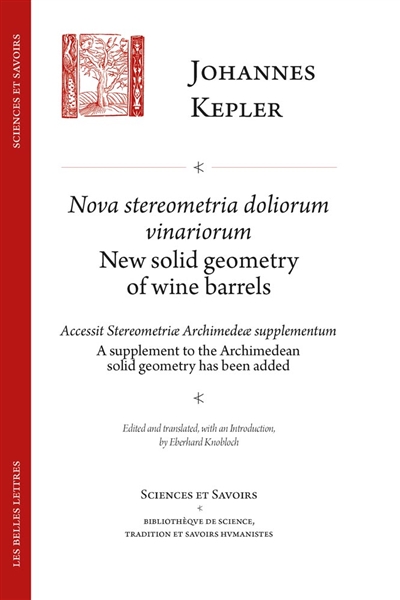en savoir plus

Carte fidélité
Permet à tous ses détenteurs d'obtenir 5% de réduction sur tous les livres lors du retrait en magasin (réduction non cumulable avec les réductions de type étudiant).
Offre également un certain nombre d'avantages auprès de nos partenaires.
Wishlist
Avec les favoris, retrouvez dans un espace les sélections effectuées au fur et à mesure de vos navigations dans le site.
Constituez pour votre usage personnel vos listes de livres en prévisions d'achats futurs et votre sélection d'articles, dossiers, événements, vidéos ou podcasts préférés ou à découvrir plus tard...
Il suffit simplement de cliquer sur "Ajout Favori" sur chaque page qui vous intéresse pour les retrouver ensuite dans votre espace personnel.
Requiert un compte Mollat
Mes Alertes
Requiert un compte Mollat
Nova stereometria doliorum vinariorum. New solid geometry of wine barrels. Accessit Stereometriae Archimedeae supplementum. A supplement to the Archimedean solid geometry has been added
Auteur : Johannes Kepler
en savoir plus
Résumé
La traduction du plus important ouvrage de mathématiques de J. Kepler, publié en 1615, et qui fit de lui un précurseur des mathématiques infinitésimales. ©Electre 2025
Lire la Quatrième de couverture
Réduire la Quatrième de couverture
Johannes Kepler (Weil der Stadt, 1571-Regensburg, 1630) is the famous astronomer and mathematician who discovered the three planetary laws named after him. In 1615 he published the Nova stereometria doliorum vinariorum // New solid geometry of wine barrels, his most important mathematical monograph. It made him a precursor of infinitesimal mathematics. He himself told the reader in the dedication to his two patrons that his second marriage caused him to write this mathematical treatise. When he stocked up with wine barrels in his capacity as head of a new family he was astonished at the way in which the seller used the gauging rod. The man explored all wine barrels with one and the same rod indifferently without paying heed to the shape, and without ratiocination or calculation.
Hence Kepler felt obliged to try to lay down, according to geometrical laws, a new foundation for the mathematical certainty of this measurement and to bring to light its fundamentals, if there should be any. To that end he began with a new interpretation of Archimedes's results in plane and solid geometry that was based on indivisibles considered as infinitely small quantities. He could not know that his Greek predecessor had used the same method in his letter to Eratosthenes, known as Περὶτῶνμηχαὶικῶνθεωρρχμάτωνἒφοδος or Approach related to mechanical theorems, rediscovered by Johan L. Heiberg in 1906. Yet, Kepler surpassed the results of his model by his own results. He investigated the volumes of surfaces of rotation like the volumes of apples, lemons, and spindles, that is, he investigated the solid geometry of figures that are closest to conoids and spheroids.
But Kepler's treatise is by no means restricted to its role in the prehistory of the calculus. The second part is full of non-trivial, new results concerning the special relations between cylinders and so-called conjugate conical frustums. He demonstrated that the Austrian barrel has the largest volume among all barrels with the same gauging length. Thus the third part explains the use of the gauging rod.
The volume presents, along with the original Latin text, the first complete translation of Kepler's monograph into any modern European language, in this case into English. The comprehensive introduction includes a survey of Kepler's life and works and explains the main ideas, methods, and results of this mathematical masterpiece.
Fiche Technique
Paru le : 17/05/2018
Thématique : Mathématiques Appliquées
Auteur(s) : Auteur : Johannes Kepler
Éditeur(s) :
Belles lettres
Collection(s) : Sciences et savoirs : bibliothèque de science, tradition et savoirs humanistes
Contributeur(s) : Editeur scientifique (ou intellectuel) : Eberhard Knobloch - Traducteur : Eberhard Knobloch
Série(s) : Non précisé.
ISBN : 978-2-251-44832-9
EAN13 : 9782251448329
Reliure : Broché
Pages : 348
Hauteur: 24.0 cm / Largeur 16.0 cm
Épaisseur: 1.8 cm
Poids: 545 g
